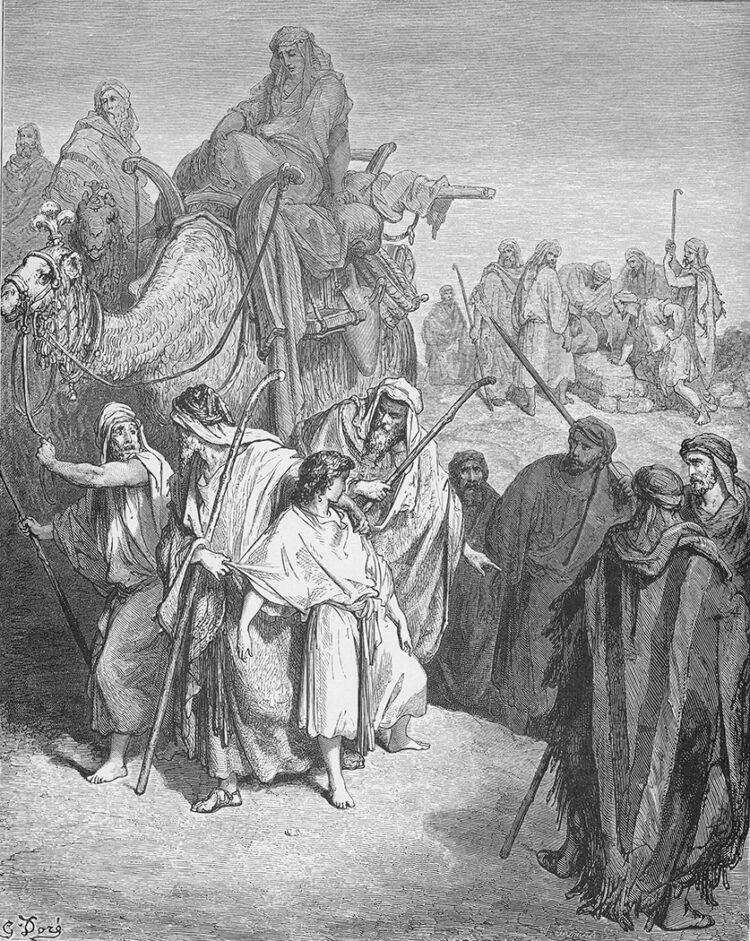Fall down, get up

The power of stories series
Jewish Family Education
With Candace R. Kwiatek, The Dayton Jewish Observer
Attacked, stripped, and dumped underground, a teen shivered while the gang debated his fate for disrespecting “the family” and making pretentious claims to power.
Traded to local traffickers and transported to a foreign country, the teen was eventually sold to the captain of an elite military guard.
Recognized for his capabilities and potential, the young slave advanced in position and power until a false accusation landed him in prison.
Nearly a decade later, he was released as a free man and pardoned by the country’s leader, who placed him in a key administrative position in the national public policy sector. His name was Joseph.
In the biblical account, Joseph descends three times: His brothers cast him into a pit, Ishmaelite traders transport him to Egypt as a slave, and he is thrown into an Egyptian prison.
“Each time, however,” writes spiritual leader Danny Maseng, “he is raised up again a better Joseph, destined for a better life.”
In Judaism, this phenomenon is known as yerida l’tzorech aliyah, a descent that facilitates an ascent. Built into the very design of all creation, it describes the patterns of history, the movement of peoples, even the nature of individual lives.

In the beginning, the Torah declares, there was chaos and darkness. Then God brought forth order and light. Dark before light.
The talmudic sages imagine Adam’s first day in the Garden. “Woe is me,” he cried as the sun set, “the world is becoming dark, returning to chaos and disorder.” When dawn broke, he said in wonderment, “Evidently, the sun sets and night arrives, and this is the order of the world.”
Night before day. Descent for the sake of ascent.
We read of Jacob’s famine-plagued family who were welcomed into Egypt like nobility, only for their descendants to be enslaved by a pharaoh “who knew not Joseph.” Hundreds of years later, Moses led them in the Exodus to Sinai. Slavery before freedom and revelation. Descent for the sake of ascent.
Involuntarily married to the pagan King Ahashverus, the Jewish Queen Esther was perfectly positioned to reveal Haman’s evil plot and save the Persian Jews. Descent for the sake of ascent.
Ruled by the increasingly tyrannical Hellenizing Syrian-Greeks, the Maccabees of Judea rebelled and triumphed. Their legacy? The first independent Jewish state in Judea in over 400 years. Inspiration to fight for religious freedom and liberty. And Chanukah, commemorating the rededication of the Temple and reminding us that light can come from darkness. Yerida l’tzorech aliyah.
In a famous letter, the Lubavitcher Rebbe used surgery to illustrate the concept that an ascent can only be achieved by a prior descent.
“A Martian entering an operating theatre wouldn’t imagine that the surgical team was doing something good by cutting the patient open,” he wrote, “that it would ultimately restore the person to health.”
Similarly, Rabbi Shlomo of Radomsk observed, “A seed will never sprout and grow unless it first disintegrates into the earth.” There is no rising without first falling, as we see in the following stories.
The Gladiator. A gladiator and bandit, Resh Lakish saw a figure bathing in the Jordan River. Jumping in to pursue it, he found only Rabbi Yochanan, who exclaimed, “Your strength is fit for Torah.” Resh Lakish countered, “Your beauty is fit for women.” Rabbi Yochanan cleverly offered, “If you return to the study of Torah, I will give you my sister in marriage, who is more beautiful than I am.” Resh Lakish accepted. Under the tutelage of Rabbi Yochanan, he became Rabbi Shimon ben Lakish, one of the most prominent Torah scholars of his generation.
The Tourist. Somber visits to Holocaust sites in Poland and the Czech Republic during a senior-year trip brought high schooler Penina Graubart face to face with her family history and the near-destruction of the Jewish people.
“I was at my lowest point,” she remembers, but there she found inspiration. Dedicating herself to protecting present and future Jews would become her new mission. She went on to explore Israel, deciding to make it her home. Today Penina attends university in Israel where she advocates on behalf of the Jewish people.
The Volunteer. “You are the most despicable, disgraceful and rude person! I think you need to change your attitude, and I wish you luck!” Miriam heard on the voice mail message. A volunteer organizer of the local gemach (free loan service), she was heartsick, her eyes filling with tears.
She had explained there was no storage room for additional items at the moment. And she had been accused of screaming. She had offered a referral to another gemach and was accused of making excuses. And now the voice mail? Could there be any truth in the caller’s accusations? On reflection, Miriam realized she was spread too thin and burned out, influencing her attitude and interactions. After making some changes, her volunteer work was once again infused with joy and kindness.
“God created the world in a way that in order to jump, you must first crouch down,” writes Rabbi Ari Shvat. “Yerida l’tzorech aliyah. There is no advancement in life without first going down.” Or, as Rabbi Sheila Peltz Weinberg puts it, “Life is an endless series of events that can be encapsulated in the phrase, ‘fall down, get up.’”
Literature to share
The Upstander: How Surviving the Holocaust Sparked Max Glauben’s Mission to Dismantle Hate by Jori Epstein. This short, powerful memoir reads like a conversation between two friends, Max and Jori, a young reporter who magically captures Max’s exuberant personality. Unusually observant from childhood, Max recounts endless experiences peppered with remembered thoughts and images along with funny and poignant anecdotes. Woven in are historical records that add another layer to his tale. He warns against the insidious nature of hate, but his ultimate message is that one must deliberately choose a positive life.
My Israel and Me by Alice McGinty. My Israel and Me takes young readers on an inviting journey through the land, history, and cultures of Israel. Told from a child’s perspective in rhyming quartets, each experience includes a prose sidebar with added detail. Colorful illustrations showcase modern cities, historical sites, landscapes, and marketplaces while portraying the diversity of Israel’s people: European, Ethiopian, Bedouin, Muslim, and more. Everyone contributes something unique to the land. An excellent introduction to Israel on many levels, highly recommended for home or school.
To read the complete May 2022 Dayton Jewish Observer, click here.





